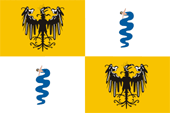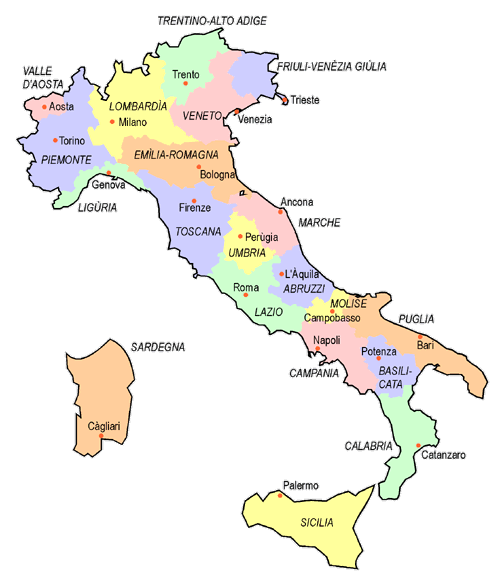mobile View, to the German Version tap the flag


- Lombardy (Mailand, Milan)
- Region of Italy
- own name: Lombardìa
• Flag
• historical Flags
• Meaning/Origin of the Flag
• Map of the regions of Italy
• Numbers and Facts
• History
• Origin of the Country's Name

Flag of Lombardy,
ratio = 2:3,
Source, by: Wikipedia (D)







1277–1397,
Flag of Lombardy,
Source, by: World Statesmen




1397–1765,
Flag of the Duchy of Milan,
Source, by: World Statesmen




1815–1866,
Kingdom of Lombardy-Venetia,
Staatsflagge,
Source, by: markodehaeck.free.fr




The flag of Lombardy is single-coloured green and shows in the middle the emblem of the region. This looks like a cross, however, it is the so-called "Rose of Camuna". It should remember the prehistoric drawings in Camuni. The historical heraldry of Lombardy, which was to found itself on the flags, is the heraldry of the Duchy of Milan under the dynasty of Visconti. From the end of the 14th century it was mixed with the heraldry of the German Empire. The coat of arms of the Visconti showed a dragon that spits out a man (bears a man). The flag of the Kingdom of Lombardy-Venetia is not handed down safely. Probably a black-golden flag was used, as it was used by the Empire of Austria as the national flag.
Source: Wikipedia (D),
Volker Preuß

all names in Italian

Source: Volker Preuß

Area: 9.213 square miles
Inhabitants: 10.104.000 (2019)
Density of Population: 1.097 inh./sq.mi.
Capital: Mailand (ital.: Milano, lombard.: Milan), 1.398.000 Ew. (2020)
Languages: Italian, Lombard
Time Zone: GMT + 1 h
Source: Wikipedia (D)

antiquity · in the today's Lombardy settle Raetians, Umbrians and Celts
since 5th cent. B.C. · immigration of Etruscians from the Alpes
since 225 B.C. · Roman conquest, establishment of the Province of Gallia Cisalpina
89 B.C. · the Province of Gallia Cisalpina gets incorporated into the Province of Italy
452 · Hun's invasions
476 · dismissal of the last Roman emperor Romulus Augustulus, end of the (West)Roman Empire, the today's Lombardy belongs until 493 to the Empire of the Odoaker
489 · conquest of the region by the Eastern Goth
568/569 · conquest and settlement by the Langobardes (from there: Lombardy)
572 · Pavia gets the capital of the Langobardian Empire
774 · conquest by the Franks
781 · incorporation of the Lombardy into the Frankish Empire of the Carolingians
843 · at the division of the Frankish Empire comes the Lombardy to the Kingdom of Italy
888 · after the vanish of the Carolingians disintegrates the Region into small states
961 · Otto I. brings the Lombardy to the German Kingdom
ca. 1000 · Milano joines the Lombardian Alliance against the German Emperor (Milano, Bergamo, Lecco, Cremona, Mantua and Brescia)
1167 · the Lombardian Alliance takes position against the German Emperor Frederick I. (Barbarossa)
1183 · recognition of the independence of the Lombardian Alliance
ca. 1215–1350 · fights between Ghibellines (emperor's party) and the Guelfes (pope's party)
1277 · Ottone Visconti takes over the power in Milano, later rules the family from Milano the whole Lombardy
1328 · the family Gonzaga takes over the power in Mantua (later Duchy of Mantua, 1708 to the House of Habsburg
1395 · Gian Galeazzo Visconti receives from the German King Wenceslaus of Luxembourg the title of the Duke of Milan
1450 · extinction of the Visconti family, the family Sforza takes over the Duchy of Milan
1499 · France intervenes in Northern Italy, the Duchy of Milan becomes a French estate
1512 · Parma gets separated by the Pope as a duchy from the Duchy of Milan
1525 · Emperor Karl V. defeats the French interventors near Pavia
1535 · the Duchy of Milan gets subordinated under a Spanish-Habsburg proconsul
1701–1714 · Spanish heritage succession war
1714 · peace treaty of Utrecht, the Duchy of Milan becomes an Austrian-Habsburg estate
1797 · after the conquest by French troops the Duchy of Milan gets dissolved and incorporated into Napolèonic satellite states
1815 · Vienna Congress, Austria purchases Venice and the Lombardy (Kingdom of Lombardy-Venetia)
1859 · Austro-French War, after the battles of Magenta and Solferino Austria has to cede Lombardy, including Bergamo and Brescia to France
1860 · France exchanges the Lombardy against Savoy and the County of Nice with Sardinia-Piedmont, Lombardy becomes in this way a part of Sardinia-Piedmont and thus a part of the in 1861 by the House of Savoy (the ruling dynasty of Sardinia-Piedmont) founded Kingdom of Italy
17th of March 1861 · coronation of Victor Emmanuel II. of Sardinia-Piedmont to the King of the Kingdom of Italy
1946 · establishment of the Lombardy region as administration unit
Source: Atlas zur Geschichte,
Wikipedia (D),
World Statesmen

The name "Lombardy" goes back to the Lombards. They came originally from the today's southern Sweden, settled later along the lower reaches of the Elbe river, and came in the 6th century to northern Italy. The name of the Lombards is often associated in connection with the idea of "long beards", and the legends seem to confirm this, however, the word goes back to the long-handled battle axes, called "long bards".
Source: Handbuch der geographischen Namen


Kindly supported by:

![]()















